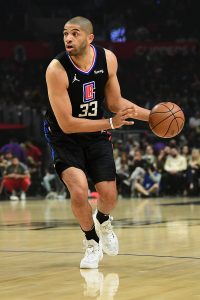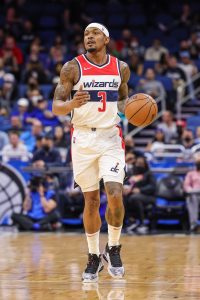Of the 19 veterans who had player options on their contracts for the 2022/23 season, 13 picked up those options, choosing the security of the guaranteed money over the uncertainty of the open market. That leaves six players who turned down their options and became unrestricted free agents.
Here’s a breakdown of how those players fared in free agency:
 Nicolas Batum
Nicolas Batum
- Option: $3,328,530 (Clippers)
- Free agent contract: Two years, $22,554,168 (Clippers).
Bobby Portis
- Option: $4,564,980 (Bucks)
- Free agent contract: Four years, $48,578,208 (Bucks). Player option. Trade kicker (15%)
Batum and Portis had been in virtually the exact same boat for the last couple years. After successful initial stints with the Clippers and Bucks, respectively, during the 2020/21 season, they re-signed in 2021 on team-friendly deals for the maximum allowable salaries they could receive using Non-Bird rights.
Having accrued Early Bird rights by this summer, both players turned down their ’22/23 options in order to sign more lucrative multiyear contracts. Portis – who is six years younger than Batum – got two extra years on his deal, but both players received starting salaries of $10,843,350, the maximum allowed this year using the Early Bird exception.
Patty Mills
- Option: $6,184,500 (Nets)
- Free agent contract: Two years, $13,281,950 (Nets). Includes unlikely incentives ($1,207,452).
Mills was one of the few players this offseason whose option decision wasn’t a no-brainer. He had a solid first year in Brooklyn, but entering his age-34 season, it was unclear how eager teams would be to give him multiple years.
As it turns out, the Nets were on board with giving him one extra year, with a modest raise. After signing a year ago for the team’s full taxpayer mid-level exception, Mills re-signed for a base salary of $6,479,000, the exact amount of this season’s taxpayer MLE. Because Brooklyn had his Non-Bird rights, the club was able to tack on some unlikely incentives to Mills’ new contract.
P.J. Tucker
- Option: $7,350,000 (Heat)
- Free agent contract: Three years, $33,043,500 (Sixers). Player option.
Tucker’s two-way contributions during the Heat’s playoff run made him a popular target in free agency this offseason, even at age 37. The three-year offer the Sixers gave him was worth the full mid-level exception and was the most that any team could put on the table for Tucker without using cap room or acquiring him via sign-and-trade (the Over-38 rule prevented Philadelphia or another team from offering four years). It’s a huge win for a player who will have celebrated his 40th birthday by the time the contract expires (unless he opts out again in 2024).
 Bradley Beal
Bradley Beal
- Option: $36,422,136 (Wizards)
- Free agent contract: Five years, $251,019,650 (Wizards). Player option. Trade kicker (15%). No-trade clause.
No player who declined an option this June made out better than Beal. In fact, Beal’s deal was easily the most lucrative of any free agent contract signed this offseason.
Not only did Beal get a five-year, maximum-salary contract that starts at 35% of the 2022/23 cap, but he also got plenty of perks, including a fifth-year player option, a trade kicker, and a full no-trade clause. He was the first NBA player in several years to receive a formal no-trade clause.
James Harden
- Option: $47,366,760 (Sixers)
- Free agent contract: Two years, $68,640,000 (Sixers). Player option. Trade kicker (15%).
Of the six players who turned down options for 2022/23, only Harden took a pay cut for the coming season. But that was a deliberate choice by the former MVP, who opted to accept a more team-friendly cap number in order to allow the 76ers to use their full mid-level exception and bi-annual exception while remaining under the hard cap.
Harden will still earn a salary worth $33MM in ’22/23, and will be in position to opt out and sign a more lucrative deal next summer if he enjoys a bounce-back year.
good for bobby for getting his bag my boy deserves it
Tbh I think he deserved even more than he got. Orlando woulda been better off with Portis than resign Bamba imo. Bamba is obv younger & may continue to improve & could possibly even become an all-star level big but chances of that are less than 50% & Portis woulda been the perfect vet to give that young team some toughness
I think going for him later when they’re competing for a playoff spot is a smarter option. He’s only 27 and I think maybe when this contract is up and assuming Paulo lives up to the hype maybe the magic will even be contenders or at least a play off team. portia would fit better then but i see what ur saying and i do think he deserves a bigger bag, obviously not the max but still a big bag
I feel like Orlando should be trying to compete for a playoff spot starting this season. They did some top notch tanking ever since they cleaned house at the 2021 trade deadline & added some premium young talent (Paolo, Franz, Suggs & Houstan). Now with Isaac comings back & Markelle healthy they just needed a seasoned vet that demands respect (from his teammates & his opponents) to push them into contender status. I def understand why he’d wanna stay in Milwaukee tho. He’s a legend up there & he’s got the best player in the world on his team
As far as staying in Milwaukee goes, yeah he’s a fan favorite and any team with the top 5 players in the league (Giannis, Luka, Steph, Jokic, Embiid) is automatically a contender. As far as Orlando goes, I could see them maybe being a play in team but I see them more as a 11th or 12th seed. I think the pistons and hornets are gonna be the play in teams. However, if Paulo plays really well from the get go you never know, they could go for a playoff spot. Milwaukee definitely benefits Porter for the meanwhile tho; he could be looking at a ring next year and I’d choose that over a potential play in spot.
Yea I def see Paolo being really good from the jump. It was always weird to me that there was ever even a thought of him not going 1st. He’s a big time baller, especially offensively. Plus they get Isaac back, they have way more continuity than most teams (their entire rotation & coaching staff return), & their youngsters will all be a yr older & improved from last season. This team is as primed as any in the league to make a big jump. And if they take my suggestion & trade for Donovan Mitchell they’re pretty much guaranteed to be the most improved team in the league. I like Detroit’s young core alot & I feel that Saddiq Bey is possibly the most underrated player in the league rn. But I like Orlando’s youngsters even more.
Saddiq is defo very underrated although I don’t think he’s the most underrated (that goes to dorian finney smith in my opinion but that might just be my mavs fan bias). orlando has one of the best young cores if not THE best young core in the entire league although i’m not a fan of suggs to be honest. but i’m a big isaac fan, big cole anthony fan and i really think paulo is going to go far. if they trade jalen suggs and salary with a couple picks for dono that would be best imo and that would solidify them a playoff spot and possibly even a second round appearance. obviously we have to keep in mind they’re a very young team and they have time to dominate in the future even with dono but unless paulo is a bust they have a very bright future. magic fans finally have something to root for.
There is never any uncertainty, or shouldn’t be. Players that opt out always do better (in some combination of AAV and years) every year. It’s not risk taking, or even a read of the market, it’s a reaction to the conclusion of the market; they only opt out when (after) they’re told by their agents that there is a better deal out there. Likewise, players that opt in aren’t doing it as risk averse course of action; they’re reacting to their agents saying they won’t get a better deal.
This is almost an article on who got overpaid this offseason.
honestly most of them deserve it
It seemed a lot of the free agents worked with teams to come out with exactly the right contract. No risk at all. It’s almost like they knew their offers before free agency started.